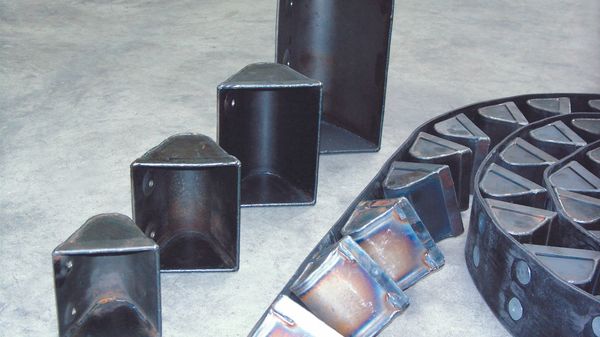The abrasive circuit of a shot blast plant:
Economical abrasive preparation
An inlet pipe feeds the abrasive directly into the centre of the blast wheel. Here it is pre-accelerated by an impeller and thus reaches the blades. The centrifugal force caused by the rotation of the wheel accelerates the abrasive and it reaches the workpiece surfaces, where it achieves its effect. It then bounces off together with the removed material, falls into a collecting hopper and is transported to the so-called bucket elevator, e.g. by a screw conveyor.
An alternative means of transport for the abrasive is a conveyor chute. The bucket elevator is a vertical shaft in which a rubber belt fitted with metal buckets is guided over two drums. The buckets are immersed in the blasting abrasive and convey it to the upper part of the machine. A collection container is located here, which is also known in blasting technology as an "abrasive bunker".
At this point, the abrasive is contaminated by the blasting process. On the one hand, it contains material that has been removed from the workpieces, and on the other hand, it contains broken abrasive, the so-called "undersized particles" and dust. The larger particles can cause disruptions in the process, while the fines have the highest abrasive effect. This not only has an effect on the workpieces, but also on the wear parts of the blasting plant itself. For this reason, the coarse and fine particles must be separated.
The coarse particles are separated by a sieve onto which the buckets of the bucket elevator pour the abrasive. Cleaning this sieve is part of the regular maintenance programme.
The fines are separated by an air stream. To do this, the abrasive is guided over a wide edge. A cascade formation takes place. Air flows through the thin veil of abrasive. The fan of the connected cartridge filter unit creates a negative pressure. The air sucked in in this way flows through the abrasive curtain and takes undersized particles and dust with it. The size of the parts that are entrained or remain in the abrasive is defined by the strength of the air flow. The better this can be adjusted, the more efficiently the machine can work. If too much abrasive is discharged, this causes unnecessary costs.
After the air flow has passed through the abrasive curtain and carried away the unwanted particles, it is guided via air ducts to the cartridge filter unit. Before the air enters the unit, it passes through a front section with an impact separator in solutions from certain manufacturers. Larger particles collide with a metal surface and fall into a discharge hopper. This is a pre-cleaning process.
The dust-laden air is sucked through filter cartridges. It settles in these. As the filter medium becomes clogged over time, the filter cartridges are cleaned at regular intervals, or at intervals determined by measuring the differential pressure, using a blast of compressed air. Before the cleaned air is discharged back into the hall or into the environment, it flows through a so-called secondary or police filter. This ensures that only purified air escapes, even if a filter cartridge bursts.
The cleaned air is either channelled back into the hall or to the outside. Separated material is sent for disposal or recycling.
The cleaned abrasive is fed into the abrasive bunker or abrasive storage container. From there, it is fed through hoses or pipes back down to the turbines. This closes the abrasive cycle.

